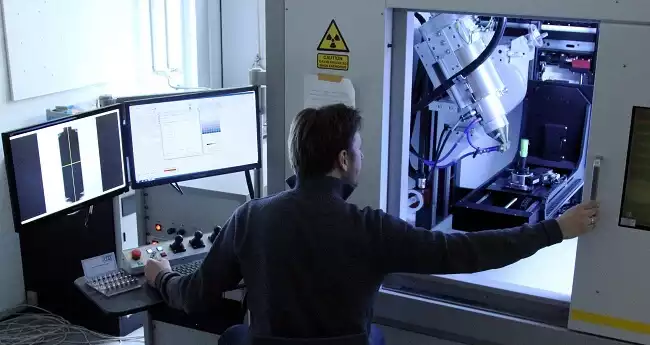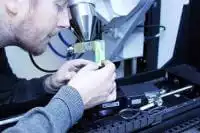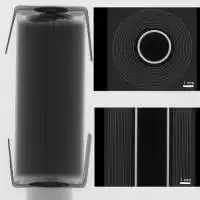DTU Energy uses industrial CT to research the development of green energy solutions.
DTU uses a high flux Nikon Metrology CT system to non-destructively investigate energy materials such as batteries and fuel cells. The high energy 225 kV microfocus source penetrates dense battery, electrolysis cell and fuel cell samples in the search for suitable materials to develop sustainable, green energy systems.
DTU Energy uses industrial CT to research the development of green energy solutions.
17-11-2016
DTU uses a high flux Nikon Metrology CT system to non-destructively investigate energy materials such as batteries and fuel cells. The high energy 225 kV microfocus source penetrates dense battery, electrolysis cell and fuel cell samples in the search for suitable materials to develop sustainable, green energy systems.

Non-renewable energy resources are used to generate approximately 85% of the world’s energy today, but the issues with these finite sources have been known for a long time. It’s not just that the supplies of fossil fuels are exhaustible and will one day be depleted but also the effect that using them has on the world. With greenhouse gases such as carbon dioxide created by burning fossil fuels contributing to global warming, we need to find alternative resources to power the world. Taking into consideration the limited reserves and the negative environmental impact of non-renewable energy resources, DTU Energy’s primary objective is to develop technologies for conversion and storage of energy, in sustainable energy systems.

Søren Bredmose Simonsen fixes the lithium iron phosphate battery in positionIn 2012, a part of the Danish national lab, Risø with over 20 years of experience in fuel cell development merged with DTU to become the department DTU Energy. The dedicated department focuses on education, research and development of functional materials and their application within sustainable energy technologies. Recognizing that with sustainable energy systems of the future, sources such as solar and wind power will fluctuate, it is vital to be able to efficiently convert and store the energy as needed. Researchers in the department work on technologies and materials for efficient conversion (e.g. fuel cells, thermos-electric cells and solar cells) and subsequent storage of different forms of energy (e.g. batteries and electrolysis cells). An example of this is that wind power may be stored by converting electricity into a fuel such as hydrogen or a hydrocarbon which can then be stored.
XT H at DTU (Denmark)
The high energy 225 kV microfocus system is used for material research in the development of sustainable energy.
- High energy/high flux penetrates dense materials
- ST system can hold large samples up to 50 kg in weight and 300 mm in diameter
- Non-destructive 3D imaging reveals what 2D cannot, providing a valuable insight
CT provides insight which cannot be obtained from 2D images
The Department of Energy Conversion and Storage has state-of-the-art laboratories with experimental facilities and continue to invest in the best equipment for their projects. Current imaging methods included electron microscopy (SEM, TEM), FIB-tomography, TOF-SIMS, XPS, neutron imaging, scanning probe microscopy and diffraction tomography. However, for material research DTU required a CT system capable of delivering insight into the often complex 3D structures characteristic of most energy conversion and storage devises.

An example
of a multi-metal targetThe complex 3D structure in batteries or in the different types of electrochemical cells can be difficult to analyse from 2D images alone. For most characterization methods, it is necessary to break or cut the materials to investigate the internal parts. With CT, it is on the contrary possible to investigate the devices in 3D non-destructively. This for example gives access to information about connectivity of pores or other parts in the devices, information which cannot be obtained from 2D images alone. The Nikon CT solutions are able to provide a valuable insight into the internal surfaces and material structure, without causing damage to the materials.
The XT H 225 ST is the extended model from Nikon Metrology which allows for samples up to 50 kg in weight and 300 mm in diameter to be scanned. The extra size and weight capacity is what DTU needed to scan heavier and larger samples such as solar, fuel and electrolysis cells. DTU selected a 16-bit PerkinElmer 1620 flat panel to obtain high-definition images. The source of XT H 225 ST is also equipped with a multi-metal target that generates the specific X-ray spectra. Beside the standard tungsten target, the operator can select 3 other materials in the target: silver (Ag), molybdenum (Mo) and copper (Cu). For some material analysis, it is often better to have the X-ray emission at lower energies, this can be achieved by using different materials as a target.
DTU required a multi-metal target due to the potential frequent usage between a variety of different departments. The wide scope of options available with the Nikon Metrology systems makes it the most flexible tool for quality laboratories, production facilities and research departments.
The system has so far been used to provide very useful information about pore fraction, pore shape and connectivity as well as interface areas between two materials and particle sizes. Another example is to investigate the internal 3D structure of batteries to track possible changes during or after aging cycles of the batteries.
Motorized FID reduces scan times.

With over 25 years of expertise, the CT specialists at Nikon Metrology have developed and manufactured complete systems, incorporating proprietary micro-focus X-ray sources, high precision 5-axis fully programmable manipulators and fast acquisition and reconstruction software.
The XT H 225 ST model comes with a motorized FID (Focal spot to Imager Distance), meaning that the detector can be moved closer to the source. A shorter FID means that the X-ray flux is increased and with a shorter imager exposure, the scan time can be reduced. DTU have made use of the high flux of the ST model to facilitate faster scans for in-situ measurements.
The motivation for buying the Nikon system was the high energy 225kV source that was able to scan materials with heavier elements and larger samples such as a batteries, solar cells and fuel/electrolysis cells.” – Søren Bredmose Simonsen – DTU Energy.
Søren Bredmose Simonsen – Researcher at DTU, explained that the high energy 225kV microfocus source was the main reason for selecting the Nikon system. “The motivation for buying the Nikon system was the high energy 225kV source that was able to scan materials with heavier elements and larger samples such as batteries, solar cells and a fuel/electrolysis cells”. With up to 225 kV and a minimum spot size of 3 µm, the 225 kV microfocus source is able to cope with a range of sample sizes and densities.
The XT H 225 ST scanner is part of DTUs new 3D imaging center which is currently being established by DTU Energy, DTU Compute, DTU Mechanics and DTU Physics. The center is focusing both on academic research and also on research and development projects in collaboration with industry. Examples are CINEMA (allianCe for ImagiNg and Modelling of Energy Applications) and LINX (Linking Industry to Neutrons and X-rays) which are projects that combine academic and industrial research.
How does CT work?
To generate a 3D CT volume, a series of sequential 2D X-ray images are captured as the object is rotated through 360°. These images are then reconstructed to generate a 3D volumetric representation of the object.
In addition to the outer surfaces, the reconstructed volume contains all information of interior surfaces and structure – as well as information on the material structure. It is possible to navigate through the CT volume at any given point, through any plane.
As a result even interior measurements can be easily obtained, as well as the added benefit of localizing structural material imperfections and identifying assembly errors not usually visible through traditional methods of NDT.

